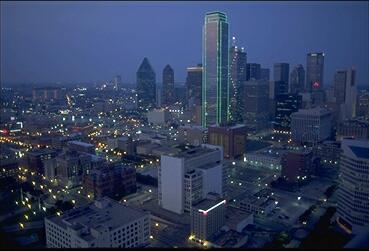
Dallas, Texas (courtesy of Gil R. Glover)

Plot Summary
Commentary
Morris builds his argument with many different interviews showing viewpoints on both sides. The people supporting Adams' conviction consist mainly of members of the police force and witnesses for the prosecution. The film carefully counters their opinions with statements from other subjects. For example, Harris' account of what happened that night is countered by his friends' claim that he was bragging about shooting the officer. Various interviewees also provide motives for why Adams was the main suspect instead of Harris. One subject described how Harris always spoke very politely to investigators, probably making it harder to imagine him as a dangerous criminal. Filmed in conventional documentary style, these interviews gradually build up strong evidence that the wrong man was convicted. In this way the film resembles an appellate court with testimony and cross-examination and the viewer trying to discern the truth.
Although they tend to be repetitious, the reenactments contrast with the more conventional documentary elements and involve the viewer more in the events under question. They provide a visual map of how things occurred at the scene; they also change as more clues are discovered. For example, as the witnesses are interviewed, the dramatization now shows their cars passing by the stopped vehicle. This technique helps the viewer to visualize the different ways the shooting could have happened and to decide which chain of events seems most plausible. The Phillip Glass music becomes stronger during these segments and evokes both a sense of loss for the officer killed and an atmosphere of mystery concerning what really happened. Images such as the repeating shot of the spinning red light and the spilling milkshake flying through the air also add to the film's powerful resonance.
Although the film presents an apparently overwhelming case for Adams' innocence, director Errol Morris has the final say on what is shown. From the number of different people interviewed and the variety of topics discussed, Morris clearly had a vast amount of footage at his disposal. A film reflects the filmmaker's viewpoints, and the viewer should remember this when being drawn into the film's "truth"; this applies to television reporting as well. One of the witnesses mentioned how justice can be blind to the truth in the court system. Film is an influential medium that can similarly obscure the truth and lead to negative consequences--consider Triumph of the Will. Nevertheless, if the entire rest of the film doesn't convince the viewer, the final interview with Harris should leave little question. With extreme close-ups of a playing tape recorder, Harris basically admits that he killed the officer and that Adams is innocent. Based on this and all the preceding evidence, the viewer is left with the notion that the film has succeeded where the justice system has failed. It's a good example of how powerful and persuasive film can be, and a hopeful turn in film's dangerous role as a medium of truth.
The Thin Blue Line is a docudrama that includes conventional elements as well as fictionalized dramatization. The film argues that Randall Adams was wrongfully convicted in the murder of a Dallas policeman in 1977 and suggests David Harris is the real culprit. The film features standard interviews with many of those involved in the incident, stylized reenactments of events surrounding the murder, and various shots of newspaper clippings.
The Thin Blue Line represents not only an important success for filmmaker Errol Morris, but it also has significant implications for one of its subjects, the convicted Randall Adams. Due to the film's convincing presentation of facts and opinions and further lobbying by Morris, Adams was eventually released.